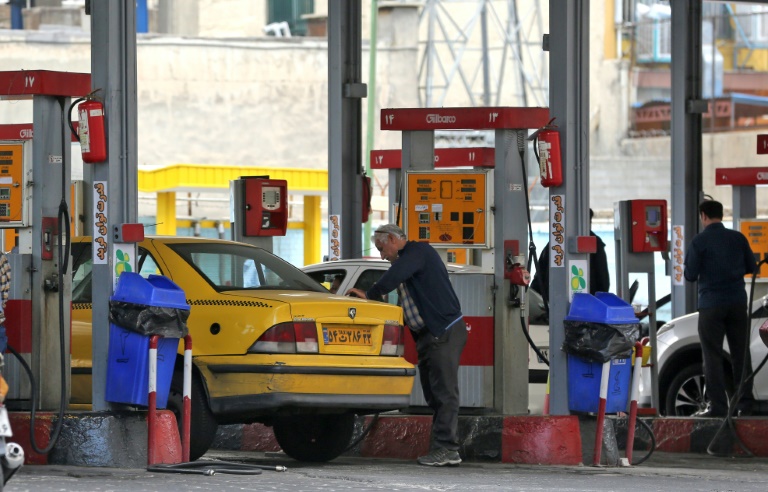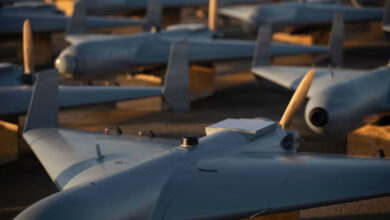
One person was killed and others injured in protests that spread across Iran on Saturday after a surprise decision to impose petrol price hikes and rationing in the country hit by US sanctions.
The death occurred in the central city of Sirjan, where people tried to set fire to a fuel depot but were thwarted by security forces including police, the Revolutionary Guards and Basij militia, the semi-official ISNA news agency reported.
The demonstrations broke out on Friday, hours after it was announced that the price of petrol would be hiked by 50 percent for the first 60 liters and 300 percent for anything above that each month.
“Unfortunately someone was killed,” Sirjan’s acting governor Mohammad Mahmoudabadi said in the report, adding that the cause of the death and whether “the individual was shot or not” was still unclear.
Mahmoudabadi emphasized that “security forces did not have permission to shoot and were only allowed to fire warning shots… which they did.”
It was a “calm gathering” that was exploited by some who “destroyed public property, damaged fuel stations and also wanted to access the oil company’s main fuel depots and set fire to them,” he said.
Besides Sirjan, “scattered” protests were also held on Friday in other cities including Abadan, Ahvaz, Bandar Abbas, Birjand, Gachsaran, Khoramshahr, Mahshahr, Mashhad and Shiraz, state news agency IRNA said.
But they were mostly limited to blocking traffic and were over by midnight, IRNA reported.
– Drivers block streets –
Fresh demonstrations were held on Saturday in the cities of Doroud, Garmsar, Gorgan, Ilam, Karaj, Khoramabad, Mehdishahr, Qazvin, Qom, Sanandaj, Shahroud and Shiraz, IRNA said.
“Some drivers have protested the new petrol price by turning off their cars and creating traffic jams,” the official news agency added.
Iran imposed petrol rationing and raised pump prices by at least 50 percent on Friday, saying the move was aimed at helping citizens in need with cash handouts.
The measure was expected to bring in 300 trillion rials (US$2.55 billion) per annum, the head of the country’s Planning and Budget Organization, Mohammad Bagher Nobakht, said on state television.
About 60 million Iranians in need would get payments ranging from 550,000 rials ($4.68) for couples to slightly more than two million rials ($17.46) for families with five members or more, he said.
Under the scheme, drivers with fuel cards will pay 15,000 rials (13 US cents) a litre for the first 60 liters of petrol bought each month, with each additional litre costing them 30,000 rials.
Fuel cards were first introduced in 2007 with a view to reforming the subsidies system and curbing large-scale smuggling.
Iran’s economy has been battered since May last year when President Donald Trump unilaterally withdrew the United States from a 2015 nuclear agreement and reimposed crippling sanctions.
The rial has plummeted in value against the US dollar, inflation is now running at more than 40 percent and the International Monetary Fund expects Iran’s economy to contract by nine percent this year and stagnate in 2020.
– ‘Under pressure’ –
President Hassan Rouhani said on Saturday that currently 75 percent of Iranians were “under pressure” and the extra revenues from the petrol price hike would go to them, and not the treasury.
Rouhani had tried to hike fuel prices in December but was blocked by parliament in the wake of protests that rocked Iran for days.
The speaker at the time ruled out the move as unpopular and said it was “not in the interests of the country”.
The rationing and price hike come at a sensitive time as Iran prepares for a parliamentary election in February.
According to Nobakht, the price hike was agreed by the High Council of Economic Coordination, made up of the president, parliament speaker and judiciary chief, implying it had received the system’s approval across the board.
Rouhani in his first term had voiced opposition to the petrol dual-price regime adopted by his predecessor, Mahmoud Ahmadinejad, saying “it caused corruption and that is why we made a unified rate” in a 2015 tweet.
His administration also scrapped Ahmadinejad’s fuel card scheme, only to revive it this year while still denying rumors it was a precursor to petrol rationing and price hikes.
Image: AFP/File / ATTA KENARE Iranian motorists fill up at a petrol station in the capital Tehran




